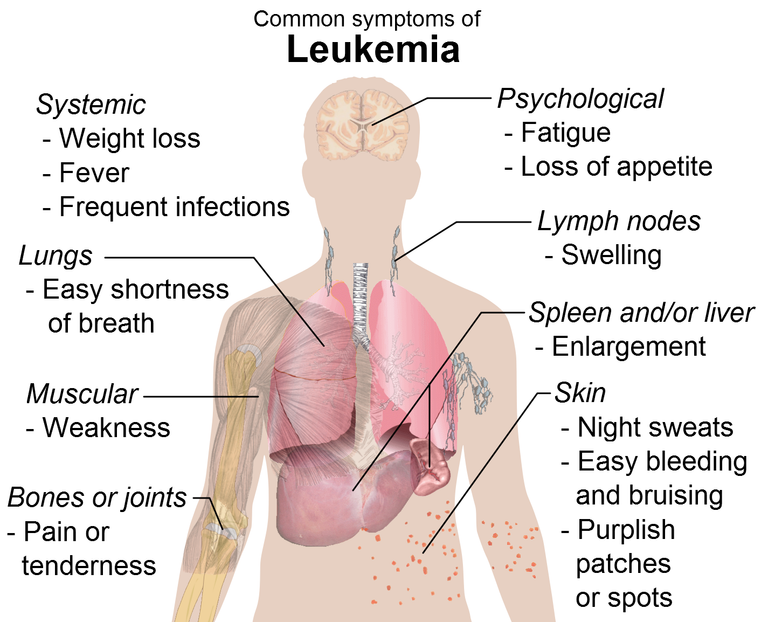Leukaemia is a type of blood cancer marked by the rapid, uncontrolled growth of abnormal blood cells. This growth occurs in the bone marrow, the primary site of blood cell production in the body. Typically, leukaemia involves immature white blood cells.
The term "leukaemia" comes from the Greek words *leukos* (meaning "white") and *haima* (meaning "blood").In contrast to other cancers, leukaemia typically does not develop into a mass (tumor) that appears on imaging tests like X-rays or CT scans.
Causes of Leukaemia
Scientists have found that leukaemia results from genetic mutations in the DNA of blood cells, primarily affecting white blood cells. These mutations, known as leukaemic changes, cause cells to grow and divide uncontrollably, leading to an accumulation of abnormal cells in the bone marrow and bloodstream, which in turn interferes with the production of healthy cells. The exact cause of these genetic mutations remains unclear.
Childhood leukaemia is the most prevalent cancer among children and adolescents, though the reasons behind its occurrence are not yet fully understood. Leukaemia exists in several types in both adults and children. In adults, the four most common types are acute lymphocytic leukaemia, acute myelogenous leukaemia, chronic lymphocytic leukaemia, and chronic myelogenous leukaemia, with acute myelogenous leukaemia being the deadliest. There is also a common belief that tattooing may lead to leukaemia.
Signs and Symptoms of Leukaemia

Leukaemia can be treated and, to some extent, cured, though recovery—both physically and emotionally—can take time. Leukaemic cells divide and spread rapidly. Acute leukemia is the most severe form, as it is life-threatening. Around 85% of individuals diagnosed with this disease will survive for at least one year. Common symptoms of leukaemia include fatigue, shortness of breath, infections, and increased bruising or bleeding.
Symptoms can vary depending on the type of leukaemia, and not everyone experiences the same signs or all of them. Most people with these symptoms are unlikely to have leukaemia, but for those who do, early diagnosis significantly increases the chances of successful treatment.
A "Ray of Hope" For Leukaemia Patients
Chemotherapy remains the primary treatment for leukemia patients, but new therapies are being discovered regularly. A promising new cell therapy targeting CD7 on leukemia cells offers potential for patients with T-cell acute lymphoblastic leukemia (T-ALL) who have not responded to standard treatments.
This approach utilizes chimeric antigen receptor (CAR) T-cell therapy, developed by researchers at the Yong Loo Lin School of Medicine at the National University of Singapore (NUS Medicine) and the National University Health System (NUHS). Between April 2019 and October 2023, 17 patients received this therapy at National University Hospital (NUH), Ospedale Pediatrico Bambino Gesù in Rome, and in Singapore.
Remarkably, 16 of these patients achieved complete remission within a month, with leukaemia cells becoming undetectable using highly sensitive flow cytometry developed by Ms. Elaine Coustan-Smith's lab at NUS Medicine.
Additionally, the FDA(Food and Drug Administration) has approved a new oral drug, revumenib, for treating acute leukaemia in children. Earlier in the year, the FDA also approved zanubrutinib for patients with Chronic Lymphocytic Leukaemia (CLL).
CAR T-cell therapy is one of the most advanced treatments for various types of leukaemia. It involves extracting immune cells from a patient’s blood, modifying them to target leukaemia, and then infusing the engineered cells back into the body.
In a recent development, patients newly diagnosed with acute myeloid leukaemia (AML) who have a FLT3 mutation will now have access to quizartinib, in combination with chemotherapy, following a decision by the Scottish Medicines Consortium (SMC). Quizartinib is an oral medication taken alongside intravenous chemotherapy. It will be administered throughout the induction, consolidation, and maintenance phases of treatment, with varying doses during the course.
Prevention of Leukaemia
There is no particular known way of preventing the dreaded disease, nevertheless avoiding tobacco, alcohol, exposure to pesticides and industrial chemicals can help.

Congratulations @zoneboy! You have completed the following achievement on the Hive blockchain And have been rewarded with New badge(s)
<table><tr><td><img src="https://images.hive.blog/60x70/https://hivebuzz.me/@zoneboy/posts.png?202411230717" /><td>You published more than 850 posts.<br />Your next target is to reach 900 posts. <p dir="auto"><sub><em>You can view your badges on <a href="https://hivebuzz.me/@zoneboy" target="_blank" rel="noreferrer noopener" title="This link will take you away from hive.blog" class="external_link">your board and compare yourself to others in the <a href="https://hivebuzz.me/ranking" target="_blank" rel="noreferrer noopener" title="This link will take you away from hive.blog" class="external_link">Ranking<br /> <sub><em>If you no longer want to receive notifications, reply to this comment with the word <code>STOPSource of potential text plagiarism 1
Source of potential text plagiarism 2
Source of potential text plagiarism 3
Source of potential text plagiarism 4
Source of potential text plagiarism 5
Source of potential text plagiarism 6
Hello.
Plagiarism is the copying & pasting of others' work without giving credit to the original author or artist.
We would appreciate it if you could avoid plagiarism of content (full or partial texts, videos, photography, art, etc.).
Thank you.
Guide: Why and How People Abuse and Plagiarise
Hive Guide: Hive 101
If you believe this comment is in error, please contact us in #appeals in Discord.